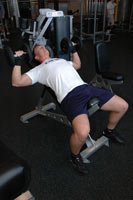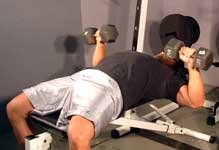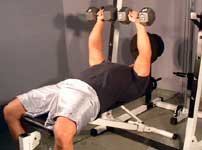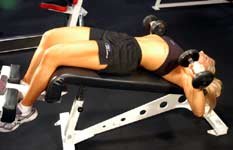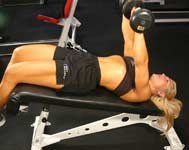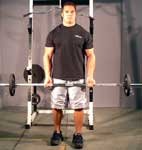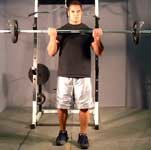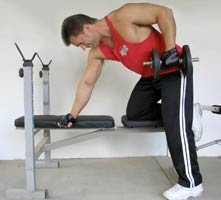| So, you've kept at it for a couple of years and see a lot of improvement from your salad days of bodybuilding. Good! Now, the bad news: the road gets a lot rougher from here on. This is point where the smart bodybuilders are separated from the rest. |


Introduction

Training
Likewise, it's tempting to skip tough exercises like deadlifts in favor of that neat lower-back machine, followed by the low-rowing machine that hits your lats just right. In short, you're getting comfortable with your routine, and that's a dead-end street.
First off, you must kill your darlings. If you always do a certain exercise it ceases to be effective as the body adjusts to it, even if you increase the weight a notch once in a while. You need to switch things around, routinely try new exercises and purposefully do "inconvenient" stuff to keep the muscles guessing. It is also very important to vary your sets and reps.
I discuss this in depth in Periodization: The Key To Continuous Gains. (For clarity, I have not taken periodization into account for the reps listed in the sample schedule below.)
To establish a framework for this constantly evolving workout routine we need to switch the old cookie-cutter workout for a more dynamic approach. To accomplish this, the sample workout below has a number of blocks into which you pick one exercise from the corresponding "pool."
Each pool, named "Chest pool #1", "Chest pool #2" etc., are tilted towards either basic meat-and-potatoes exercises like dumbbell presses or movements like cable crossover flies where the focus is more on mind-muscle connection and "feel". Both types have their place in your workout, and the frame below makes sure you always get some of each.
It may feel a bit unusual at first, but as you get used to this type of mix-and-match workouts you'll appreciate the flexibility. By constantly changing the exercises around, especially in combination with alternating high rep/low weight and low rep/high weight training, you should avoid plateaus and enjoy continuous progress.
At the same time, having a set frame with so-and-so many exercises for a particular bodypart, of which 2 or 3 are classic mass-builders from different angles and 1 or 2 are "feel" exercises, you can be sure no muscle group is falling between the chairs. All right, let's have a look at a sample schedule to see how we put it together:

Sample Dynamic Schedule
| Exercise | Sets | Reps |
| Chest #1 | 2 | 6-8 |
| Chest #2 | 2 | 6-8 |
| Chest #3 | 2 | 8-10 |
| Chest/Triceps #4 | 2 | 8-10 |
| Triceps #1 | 2 | 8-10 |
| Triceps #2 | 2 | 8-10 |
| Triceps #3 | 2 | 8-10 |
Pick one exercise from each of these pools and insert:
Chest Pool #1
| Exercise | Sets | Reps |
| Flat dumbbell presses | 2 | 6-8 |
| Decline dumbbell presses | 2 | 6-8 |
| Flat iso-lateral bench press machine | 2 | 6-8 |
Chest Pool #2
| Exercise | Sets | Reps |
| Barbell military presses | 2 | 6-8 |
| Arnold presses | 2 | 6-8 |
| Incline dumbbell presses | 2 | 6-8 |
Chest Pool #3
| Exercise | Sets | Reps |
| Pec-deck flies | 2 | 8-10 |
| Cable crossover flies | 2 | 8-10 |
| Dumbbell pullovers | 2 | 8-10 |
Chest/Triceps Pool #4
| Exercise | Sets | Reps |
| Dips | 2 | 8-10 |
| Close-grip bench press on flat bench | 2 | 8-10 |
| Military-style push-ups | 2 | Unlimted |
Triceps Pool #1
| Exercise | Sets | Reps |
| Skullcrushers | 2 | 6-8 |
| Standing barbell tricep presses | 2 | 6-8 |
| Cable tricep pushdowns (V-handle) | 2 | 6-8 |
Triceps Pool #2
| Exercise | Sets | Reps |
| One-arm dumbbell tricep extensions | 3 | 8-10 |
| Low cable tricep extensions | 3 | 8-10 |
| Kneeling cable tricep extensions | 3 | 8-10 |
Triceps Pool #3
| Exercise | Sets | Reps |
| Dumbbell kickbacks | 2 | 10-12 |
| Lying dumbbell tricep extensions | 2 | 10-12 |
| One-arm cable reverse pushdowns | 2 | 10-12 |
EXAMPLE:
| Exercise | Sets | Reps |
| Flat iso-lateral bench press machine (option 3) | 2 | 6-8 |
| Barbell military presses (option 1) | 2 | 6-8 |
| Cable crossover flies (option 2) | 2 | 8-10 |
| Close-grip bench press on flat bench (option 2) | 2 | 8-10 |
| Cable tricep pushdowns (option 3) | 2 | 6-8 |
| One-arm dumbbell tricep extensions (option 1) | 3 | 8-10 |
| One-arm cable reverse pushdowns (option 3) | 2 | 10-12 |
The 3 exercises in each pool above are just samples -- you can expand and adjust your own pools as you see fit with a dozen or more options for each pool. The more exercises you add, the more variety you will enjoy while still keeping your workouts structured. For more exercises, check out Bodybuilding.com's exercise database,
As for when to train each body part, you can stick with a 3-day or 4-day split as outlined in the Intermediate-chapter, or go to a 5-day or even 6-day split. Personally, I prefer a 5-day split over the course of a week as outlined below:
- Day 1: Chest/Triceps
Day 2: Quads/Hamstrings
Day 3: Rest
Day 4: Back
Day 5: Calfs/Shoulders
Day 6: Biceps/Forearms/Abs
Day 7: Rest
The sample schedule above is what I use for Day 1: Chest/Triceps. It's a short, intense workout that takes about 30 minutes (not counting warmup) and is just enough to trigger growth without depleting stored energy. Some prefer to stick with a 3-days-a-week schedule - that's fine too, the important thing is that you find a schedule that allows you to get productive workouts and provide enough time to recover.

Diet
Muscle mass is active tissue that burns calories 24/7, and the more you put on the more your metabolism will go up, which in turn forces you to adjust your daily caloric intake upwards to meet the demand. If you don't, you could stunt further progress by not feeding your body the extra calories it needs to add more muscle mass.
It's all tuning at this point, and once you've found your new equilibrium, make a note of it and use it as your permanent target intake until you've gained more mass and repeat the process.
Of course, ectomorphs don't have to worry about any of this - just keep eating as much good stuff as you can and you'll be fine! Also, if you're an endomorph or mesomorph and all the fine-tuning above makes your skin crawl, you could go with the classic bulk-and-diet cycle instead.
It gives more leeway during the bulk-phase, allowing you to eat the stuff you want for 6 months or so, but on the other hand you have to suffer a few months of tight dieting and cardio afterwards to burn off the body fat you accumulated. I prefer the fine-tuning approach to wild yo-yo swings, but ultimately it comes down to personal preference.

Supplements
Unfortunately, unless you're Bill Gates, taking ALL available supplements at the same time is not economically feasible and probably not even desirable. For a more realistic approach, pick one or two supplements beyond your staples (vitamins,protein, creatine, vitamin C) at the time and give them a shot.
Not everyone reacts the same way to a specific supplement, so you want to get an idea of what works best for you before you make a habit out of sinking hard-earned money into buying something every month. Let's have a look at some of the products available out there.
Thermogenic Enhancers -
- Also known as "fat burners" - Can be a good help for burning body fat, but hardly the kind of magic pill the marketers in the muscle mags would have you believe. Though many manufacturers are switching to ephedra-free formulas, the classic fat burner is a combination of ephedrine/caffeine/aspirin ("E/C/A") that works synergistically to pump up your metabolism and help you burn more calories.
There are two sides to this story: First off, it's a very effective supplement that delivers. Secondly, it's a potent central stimulant and isn't for everyone. You can read more about ephedra here.
CLA -
- Conjugated Linoleic Acid, or CLA for short, is a free fatty acid that, like creatine, occurs naturally in small amounts in a variety of foods. To avoid having to eat huge quantities of meat and dairy products every day, bodybuilders can take CLA in capsule-form to enjoy benefits such as building muscle and reducing body fat.
Pyruvate -
- Pyruvate is the starter of Kreb's cycle, the energy cycle that produces ATP and its precursors. It has shown good effect on enhancing fat burn and increasing athletic performance, making it a popular supplement.
BCAAs -
- BCAA's position as a staple supplement for millions of bodybuilders is well deserved - it has a proven track record and the scientific data to back it up. The product itself is pretty simple: 3 essential amino acids, Valine, Leucine and Isoleucine, combined into a potent cocktail focused on enhancing your bodybuilding progress.
In addition to the benefits above, BCAAs also help stimulate protein synthesis, enhance endurance and - perhaps most important of all - is highly anticatabolic, i.e. helps prevent your muscle from getting cannibalized.
Glucosamine -
- Glucosamine is a building block of cartilage and can be very beneficial in healing connective tissue. I have successfully used glucosamine supplementation daily for years, which - knock on wood - has kept the old joint problems with my knees and a previously torn shoulder at bay. However, glucosamine can also be taken as a precautionary supplement, as it helps "cushion" the joints and ligaments, possibly helping you avoid injuries in the first place.
HMB -
- Beta-hydroxy beta-methylbutyrate (HMB) is a metabolite of the essential amino acid leucine that plays a role in muscle synthesis, i.e muscle growth. In addition, studies suggest it can be aiding in fat loss, making it a double-whammy of good news for bodybuilders.
Guggulsterones -
- Guggul may have a funny-sounding name, but it sure can crank up the heat! It stimulates the thyroid to release more thyroid hormones, which in turn puts the metabolism in overdrive. Studies have shown that Guggulsterones can even treat certain hypothyroidal conditions.
GABA -
- GABA is a relatively obscure bodybuilding supplement that works by stimulating the production of HGH. This makes it a good aid in fat loss for people whose HGH-levels have begun their inevitable decline due to the aging process. GABA is classified as a neurotransmitter and has the added bonus of helping you sleep and rest better, which could translate to better workouts.
Chromium Picolinate -
- Chromium picolinate is not a whiz-bang, overnight type of supplement, but long-term use can be helpful in keeping the insulin receptors primed for optimal use. This helps stabilize the blood sugar levels and makes glucose uptake (muscle fuel) run smoothly.
This type of fine-tuned insulin management enables to body to do more with less (remember, insulin also pushes the body to store more fat so it's good if you can reap the positive qualities of insulin with less of it floating around.) This in turn can help you lose fat and build muscle.
Tribulus Terrestis -
- Tribulus Terrestis increases the production of Luteinizing Hormone (LH), which in turn increases the natural testosterone levels.
Forskolin -
- Forskolin stimulates the thyroid gland to increase the release of thyroid hormones, which helps turn up the body's thermostat and get the fat burn going. In addition, forskolin has historically been used to treat a wide variety of ailments ranging from eczema to respiratory problems.
Chrysin -
- Chrysin is an isoflavone chemically extracted from plants with the potential to increase testosterone levels in athletes. As opposed to DHEA, andro and other prehormones, chrysin works by preventing the conversion (aromatization) of testosterone into estrogen.

Sample Supplement Schedule
| When | Supplement | Dose |
| 8:00 A.M. | Daily One multivitamin/mineral (with breakfast) | 1 capsule |
| Glutamine | 5 grams | |
| Glucosamine | 1,500 mg | |
| Chromium picolinate | 200 mcg | |
| 12:00 PM | Vitamin C (w. lunch) | 500 mg |
| 4:00 PM | Gainer drink (with pre-workout snack) | 2 scoops w. water |
| Creatine | 5 grams | |
| HMB | 1,500 mg | |
| 6:30 PM | Creatine (with something sugary) | 5 grams |
| Glutamine | 10 grams | |
| HMB | 1,000 mg | |
| 7:00 PM | Vitamin C (w. dinner) | 500 mg |
| 10:30 PM | Pure protein drink (pre-bedtime snack) | 2 scoops w. water |
| HMB | 1,500 mg |

Tips & Tricks
- Be on the lookout for signs of overtraining. You have to be dedicated and persistent to become a successful bodybuilder, but there are times when you need to back off. Insomnia, irritability, fatigue, prolonged soreness and lack of enthusiasm for the training can be signs of overtraining. Take a break!
You've been hammering your muscles every week for months or even years on end, so give them a week or two of total rest to recover. You may feel guilty at first, but odds are you'll come back stronger and more energized which translates to better results when you get back on track again. Just remember to keep eating plenty of protein to aid the recovery process.
- While not listed as a bodypart on its own, it doesn't hurt to throw in a couple sets of neck training on back day. Earlier, you got enough stimulation from deadlifts and shrugs, but as you get more serious you may want to complete the "look".
The neck is visible year-round and, whether you like it or not, other people judge you unconsciously as weaker than you really are if your neck is skinny. If you're genetically blessed and was born with a bull neck, hey, no need to sweat it, but the rest of us may find it worth an extra 5-10 minutes per week.
- Don't let stretching become an afterthought. By stretching out the muscle you help blood with fresh nutrients flow into the muscle, which speeds up the recovery process. There is also a theory that stretching helps loosen up the fascial encasements around the muscle fibers, which gives them more room to grow.
In addition, animal tests have shown that stretching can trigger hyperplasia (increased number of muscle cells) though this phenomenon has yet to be confirmed in humans.
- Once again, take good care of your joints and ligaments. As a beginner you could get away with jerking the weights around, but as the number of plates go up your safety margins shrink. If a joint snaps, you're out of the gym for months.
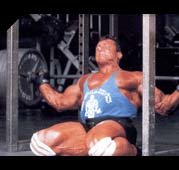 Oh, and you're in a world of pain too - remember the facial expression of Pierre Fux when he tore both knees during that Flex Magazine photo shoot last year next time you get tempted to compromise safety and good form. The ground rules for joint care are:
Oh, and you're in a world of pain too - remember the facial expression of Pierre Fux when he tore both knees during that Flex Magazine photo shoot last year next time you get tempted to compromise safety and good form. The ground rules for joint care are: - Always control the weight.
- Never bounce the weight.
- Never overstretch a joint.
- Never let the muscle rest while letting a joint or ligament "hold the load" (seated hamstring curls are notorious for this).
- An unfortunate pitfall of experienced bodybuilders is that we sometimes get intolerant towards newcomers who may not have figured out the gym etiquette yet.
Remember, you too were a beginner once upon a time so chill out and keep things in perspective. Don't get mad when a beginner mindlessly stands too close to you while you're doing your bicep curls, just take a step to the side and keep your focus on your workout.
In addition, consider supplementing with 1,500 mg glucosamine per day as a precaution.
If you always get to the gym at 6 PM and always use a specific locker, don't give the glare to the newbie who unknowingly snagged it a minute before you showed up.
Keep your cool when he forgets to wipe his sweat off the bench - politely explain that gym rules dictates everyone must wipe down the equipment after themselves and point to the where the disinfectant spray and paper towels are. You get the idea - be tolerant and help them get on the right track. Besides, seething and holding grudges steals valuable energy and mental focus away from your workout.

Intensity Boosters
Negative Training & Forced Negatives - Learn More
- The muscle is up to 40% stronger in the negative phase than the positive phase. This is a security mechanism of the body; anything you're strong enough to hoist over your head, you can at least give a controlled descent rather than have it crash down and crack your skull open.
What makes this phenomena interesting is that you can tap into this "bonus" strength by employing training that specifically takes advantage of the difference between positive and negative strength. Please note, however, that you're essentially bypassing your body's built-in safety valves here.
You're walking a thin line between clobbering your muscles and injury, so be sure to employ VERY strict form and limiting your negative training to only once every couple of weeks, at most, for any specific muscle. Needless to say, you should avoid negatives altogether if you've had recent injuries, joint problems or any other reason to believe you are somehow weakened in that area.
The idea is to use more weight than you normally handle and focus only the negative phase. For example, if you normally bench press 300 lbs for 6 reps, you may choose to load on 350 lbs for 6 to 8 reps. Your partner helps you push the weight up (positive phase) while you slowly resist the weight all the way down on your own (negative phase).
Hold statically for a second at the bottom and let your partner help you bring it up again, and so on. Another variation is to use your normal 300 lbs and have your partner actively push down during the negative phase ("forced negatives") of each rep. The advantage of this is that he can vary the pressure depending on your fatigue, which ironically is also the downside - it's hard to track progress or even guess just how many pounds' worth of pressure he added to your set.
Partial Reps (aka. burns) - Learn More
- You've probably noticed that you have "sticking points" for certain movements - your biceps usually give in at a certain point during a curl, the barbell usually stops at so-and-so many inches off your chest and so on. This is the point where you're biomechanically at your weakest.
Partial reps targets precisely that sticking point and can help you move on to heavier weights. It's hard to scientifically explain exactly why this works, but there are enough real-life anecdotes out there to include this method here.
The execution varies; either do an entire set of partials or use them as a finisher after your regular set. An example of the former would be doing bicep curls where you grab a dumbbell and only bend your elbow 45-60 degrees from start to stop through an entire set.
For the latter, you do your regular set to failure, then immediately grab a 30% or so lighter dumbbell and grind out another 6-8 partial reps to give your sticking point an extra kick in the pants. Expect pain! Partial reps are sometimes referred to as "burns", and once you're doing them you'll know why.
Cheating - Learn More
- The very idea of including cheating in your workouts may seem to fly in the face of all the earlier talk about safety and the benefits of proper form. This is not necessarily true -- cheating is a valid intensity booster if it fulfills certain criteria. You can read more details on proper cheating here.
The bottom line is that the cheating should not detract from the regular reps, nor should it involve other muscle groups than those targeted for training. Furthermore, there are a number of safety issues that need to be addressed; again, read my in-depth article on cheating to get the bottom line.
Ballistic Training (aka. CAT training) - Learn More
- Also known as Compensatory Acceleration Training (CAT), this is an advanced intensity booster that specifically targets the larger white, fast-twitch muscle fibers. The idea is to try and accelerate the weight through the positive phase, creating an effect similar to if you had used more weight than is actually on the bar.
But, and here's the kicker, it only has this "extra weight" effect as long as you're accelerating - as soon as you stop trying to accelerate and goes back to doing a regular rep, the barbell reverts to its normal weight.
Make sense? Compare it to pushing a car in neutral on a flat surface - if you start slowly and gradually increases the speed, it's not that hard to get it rolling at walking pace. However, try to get it rolling at walking pace in less than three seconds (increased acceleration) and you're suddenly working your butt off.
Translated to a bench press, this means you can make a 200 lb bench press feel like 300 lbs by accelerating through the movement. Now, suppose you have a sticking point halfway through the movement. By using ballistic training you can make the 200 lbs feel like and be as effective as your regular 300 lb benching, but you can slow down the acceleration through the sticking point, cutting the weight to 200-250 lbs for a split second, thus enabling you to complete the set without having the sticking point holding you back.

The Mental Game
Adopting a dynamic, ever-changing workout schedule like the one outlined earlier is a good start, but no variety of exercises can help you if your heart isn't in it anymore.
Sometimes a new training partner will do the trick. Or join a new gym. Or ditch your old workout routine and train like a powerlifter for a couple of months. Heck, sometimes even taking a month off (!) can be beneficial for the long-term results - you should be itching for the feel of a barbell in your hands again by the time you get back and your regained enthusiasm will pick up the slack and then some within a few months.
If you're looking for a real challenge for yourself, consider signing up for a local bodybuilding contest. Suddenly you have a deadline on the horizon to whip yourself into shape! In addition, you have a whole slew of new aspects of bodybuilding to learn and master, from pre-contest dieting to posing and choosing the right trunks.
As the stakes go up, so will your dedication and effort - or you'll face public humiliation on C-Day if you don't have your act together. Besides, if there ever was a time to take some pictures, it's the days before a contest. Even if you don't win you'll at least have something to look back on to inspire you for your next diet or contest.

